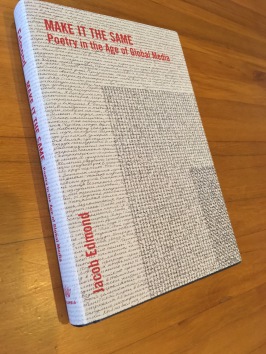
V. A Favorskii’s illustration to I. A. Krylov’s fable “Liubopytnyi” (“The Inquisitive Man”)
My article “The Elephant in the Room: Literary Theory in World Literature” has just been published online here. It will appear soon in print as part of a special issue of Orbis Litterarum entitled “Literary Studies across Cultures: A Chinese-European Dialogue,” edited by Svend Erik Larsen and Cao Shunqin. In my essay, I have some fun spotting elephants while exploring one problem with current theories of world literature: they pay too little attention to how literary theory shapes literary practice. I illustrate theory’s crucial role in world literature through the work of two influential contemporary poet–translators: Chinese poet Bei Dao’s 北島 use of Russian Formalist theory; and Anglo‐Canadian digital poet John Cayley’s deployment of aesthetic theory derived from Huayan 華嚴 Buddhism.
Here’s an extract from the introduction:
We often think about the challenge of translating literature in terms of form and content. Should one attempt to preserve the semantic content of, say, a Chinese poem in English translation, or should one attempt to replicate such formal devices as rhyme, rhythm, and wordplay? This form‐content way of thinking also inflects discussions of literature on a global scale. Franco Moretti has influentially argued that the story of modern literature is largely one of foreign, primarily European forms, such as the novel, inflected by local content, be it Chinese or West African. Jahan Ramazani likewise depends on the form‐content binary in his four‐part taxonomy of the various possible permutations of the foreign and the local in contemporary poetry: foreign form and local content, foreign form and foreign content, local form and foreign content, and local form and local content (Ramazani, 2016, 122). Ramazani’s taxonomy is finer‐grained than Moretti’s, though, as he admits, even this variegated account of “local‐global enmeshments” in contemporary poetry has its limitations, since “most poems will fit into several of these slots at once, and no amount of long‐distance squinting can accurately reduce them to one or the other” (p. 123).
Like Krylov’s inquisitive man, instead of squinting harder at our existing conceptual objects, we need to step back and recognize the elephant in the room of world literature. Moretti’s, Ramazani’s, and many other accounts of global modernism and world literature neglect a third critical term that profoundly shapes how writers and their translators conceive of and negotiate between form and content: literary theory. The main problem with both Moretti’s and Ramazani’s accounts is not that they fail to capture the complex negotiations between form and content, and between the foreign and the local, but that both their schemas ignore this crucial third term in cross‐cultural literary exchange and globalization.
And here’s the essay’s conclusion:
When it was proposed that Vladimir Nabokov be appointed to the faculty of Harvard University, Roman Jakobson quipped, “are we next to invite an elephant to be Professor of Zoology?” (quoted in Boyd, 1991, 303). In fact, it is the persistence of this way of thinking that has contributed to theory’s position as the elephant in the room of current accounts of literature on a global scale.
The history of literary theory belies a clear distinction between theorist and practitioner. Theories of literature respond to literary practices, and those theories can in turn spur new directions in verbal art. The Russian avant‐garde, for instance, inspired the theories of Jakobson and of his Russian Formalist colleague Shklovsky, whose experiments in prose fiction in turn exemplify many of the literary devices that his theory describes. In Third Factory, for example, Shklovsky deploys the device of estrangement in describing his son’s first impression of a horse: “he thought it was doing four legs and a long nose just for fun” (Shklovsky, 1926, 13). And yet amidst the conflicts between creative writing and literary theory that continue to plague the study of literature today, it is easy to lose sight of the mutually enabling role of literary theory and practice, even if, like Jakobson, your work emerges through their intermingling.
As the examples of Bei Dao and Cayley illustrate, we need to overcome this divide if we are to recognize the role of poetic theory in the translation and adaptation of literary practices across geographic and linguistic borders. We ought not to be able to write a history of modern and contemporary poetry in Chinese or English—let alone a history of global modernism and world literature—without recognizing theory’s role in shaping both how writers translate the form and content of poetic texts into new languages, cultures, and media, and how they question what we mean by form, content, medium, translation, and comparison in the first place. It’s time, in other words, to make room for elephants.
 It’s official: Make It the Same: Poetry in the Age of Global Media is in the world. It is available now from Columbia UP (use the code CUP30 for a 30% discount), Amazon, and other booksellers.
It’s official: Make It the Same: Poetry in the Age of Global Media is in the world. It is available now from Columbia UP (use the code CUP30 for a 30% discount), Amazon, and other booksellers.
 I have created a
I have created a  I’m delighted to announce that my new book,
I’m delighted to announce that my new book, 

 I’ve just published a brief essay on censorship inside and outside China on the Critical Inquiry blog, “In the Moment.”
I’ve just published a brief essay on censorship inside and outside China on the Critical Inquiry blog, “In the Moment.” 

 Is “make it the same”––and not “make it new”––the true catchphrase of modernism? So I argue in my contribution to
Is “make it the same”––and not “make it new”––the true catchphrase of modernism? So I argue in my contribution to